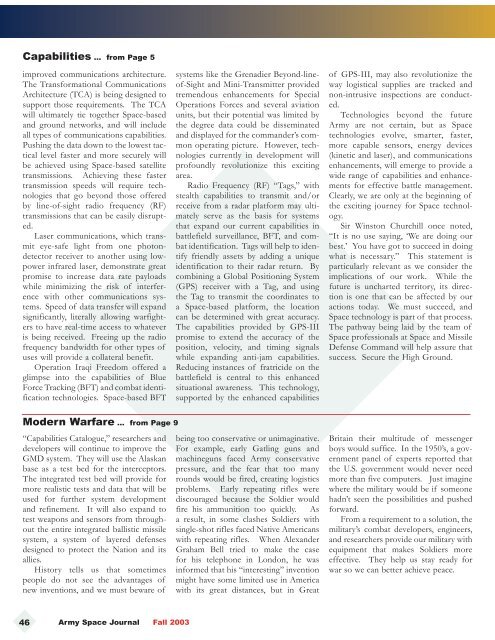Volume 2, Number 4 - Space and Missile Defense Command - U.S. ...
Volume 2, Number 4 - Space and Missile Defense Command - U.S. ...
Volume 2, Number 4 - Space and Missile Defense Command - U.S. ...
You also want an ePaper? Increase the reach of your titles
YUMPU automatically turns print PDFs into web optimized ePapers that Google loves.
Capabilities ... from Page 5<br />
improved communications architecture.<br />
The Transformational Communications<br />
Architecture (TCA) is being designed to<br />
support those requirements. The TCA<br />
will ultimately tie together <strong>Space</strong>-based<br />
<strong>and</strong> ground networks, <strong>and</strong> will include<br />
all types of communications capabilities.<br />
Pushing the data down to the lowest tactical<br />
level faster <strong>and</strong> more securely will<br />
be achieved using <strong>Space</strong>-based satellite<br />
transmissions. Achieving these faster<br />
transmission speeds will require technologies<br />
that go beyond those offered<br />
by line-of-sight radio frequency (RF)<br />
transmissions that can be easily disrupted.<br />
Laser communications, which transmit<br />
eye-safe light from one photondetector<br />
receiver to another using lowpower<br />
infrared laser, demonstrate great<br />
promise to increase data rate payloads<br />
while minimizing the risk of interference<br />
with other communications systems.<br />
Speed of data transfer will exp<strong>and</strong><br />
significantly, literally allowing warfighters<br />
to have real-time access to whatever<br />
is being received. Freeing up the radio<br />
frequency b<strong>and</strong>width for other types of<br />
uses will provide a collateral benefit.<br />
Operation Iraqi Freedom offered a<br />
glimpse into the capabilities of Blue<br />
Force Tracking (BFT) <strong>and</strong> combat identification<br />
technologies. <strong>Space</strong>-based BFT<br />
systems like the Grenadier Beyond-lineof-Sight<br />
<strong>and</strong> Mini-Transmitter provided<br />
tremendous enhancements for Special<br />
Operations Forces <strong>and</strong> several aviation<br />
units, but their potential was limited by<br />
the degree data could be disseminated<br />
<strong>and</strong> displayed for the comm<strong>and</strong>er’s common<br />
operating picture. However, technologies<br />
currently in development will<br />
profoundly revolutionize this exciting<br />
area.<br />
Radio Frequency (RF) “Tags,” with<br />
stealth capabilities to transmit <strong>and</strong>/or<br />
receive from a radar platform may ultimately<br />
serve as the basis for systems<br />
that exp<strong>and</strong> our current capabilities in<br />
battlefield surveillance, BFT, <strong>and</strong> combat<br />
identification. Tags will help to identify<br />
friendly assets by adding a unique<br />
identification to their radar return. By<br />
combining a Global Positioning System<br />
(GPS) receiver with a Tag, <strong>and</strong> using<br />
the Tag to transmit the coordinates to<br />
a <strong>Space</strong>-based platform, the location<br />
can be determined with great accuracy.<br />
The capabilities provided by GPS-III<br />
promise to extend the accuracy of the<br />
position, velocity, <strong>and</strong> timing signals<br />
while exp<strong>and</strong>ing anti-jam capabilities.<br />
Reducing instances of fratricide on the<br />
battlefield is central to this enhanced<br />
situational awareness. This technology,<br />
supported by the enhanced capabilities<br />
of GPS-III, may also revolutionize the<br />
way logistical supplies are tracked <strong>and</strong><br />
non-intrusive inspections are conducted.<br />
Technologies beyond the future<br />
Army are not certain, but as <strong>Space</strong><br />
technologies evolve, smarter, faster,<br />
more capable sensors, energy devices<br />
(kinetic <strong>and</strong> laser), <strong>and</strong> communications<br />
enhancements, will emerge to provide a<br />
wide range of capabilities <strong>and</strong> enhancements<br />
for effective battle management.<br />
Clearly, we are only at the beginning of<br />
the exciting journey for <strong>Space</strong> technology.<br />
Sir Winston Churchill once noted,<br />
“It is no use saying, ‘We are doing our<br />
best.’ You have got to succeed in doing<br />
what is necessary.” This statement is<br />
particularly relevant as we consider the<br />
implications of our work. While the<br />
future is uncharted territory, its direction<br />
is one that can be affected by our<br />
actions today. We must succeed, <strong>and</strong><br />
<strong>Space</strong> technology is part of that process.<br />
The pathway being laid by the team of<br />
<strong>Space</strong> professionals at <strong>Space</strong> <strong>and</strong> <strong>Missile</strong><br />
<strong>Defense</strong> Comm<strong>and</strong> will help assure that<br />
success. Secure the High Ground.<br />
Modern Warfare ... from Page 9<br />
“Capabilities Catalogue,” researchers <strong>and</strong><br />
developers will continue to improve the<br />
GMD system. They will use the Alaskan<br />
base as a test bed for the interceptors.<br />
The integrated test bed will provide for<br />
more realistic tests <strong>and</strong> data that will be<br />
used for further system development<br />
<strong>and</strong> refinement. It will also exp<strong>and</strong> to<br />
test weapons <strong>and</strong> sensors from throughout<br />
the entire integrated ballistic missile<br />
system, a system of layered defenses<br />
designed to protect the Nation <strong>and</strong> its<br />
allies.<br />
History tells us that sometimes<br />
people do not see the advantages of<br />
new inventions, <strong>and</strong> we must beware of<br />
being too conservative or unimaginative.<br />
For example, early Gatling guns <strong>and</strong><br />
machineguns faced Army conservative<br />
pressure, <strong>and</strong> the fear that too many<br />
rounds would be fired, creating logistics<br />
problems. Early repeating rifles were<br />
discouraged because the Soldier would<br />
fire his ammunition too quickly. As<br />
a result, in some clashes Soldiers with<br />
single-shot rifles faced Native Americans<br />
with repeating rifles. When Alex<strong>and</strong>er<br />
Graham Bell tried to make the case<br />
for his telephone in London, he was<br />
informed that his “interesting” invention<br />
might have some limited use in America<br />
with its great distances, but in Great<br />
Britain their multitude of messenger<br />
boys would suffice. In the 1950’s, a government<br />
panel of experts reported that<br />
the U.S. government would never need<br />
more than five computers. Just imagine<br />
where the military would be if someone<br />
hadn’t seen the possibilities <strong>and</strong> pushed<br />
forward.<br />
From a requirement to a solution, the<br />
military’s combat developers, engineers,<br />
<strong>and</strong> researchers provide our military with<br />
equipment that makes Soldiers more<br />
effective. They help us stay ready for<br />
war so we can better achieve peace.<br />
46<br />
Army <strong>Space</strong> Journal Fall 2003

















